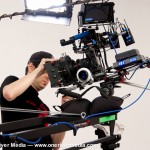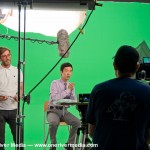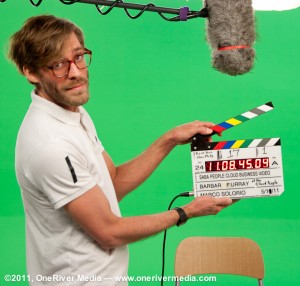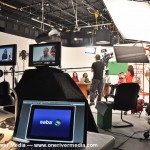OneRiver Media was recently brought on board to help produce a video for Saba Software. Miner Productions is the main producing agency (Tracey Miner as producer), OneRiver Media was brought on for director of photography and technical director (both assigned to Marco Solorio) and all post-production, and Left Coast Productions (Barbara Murray) was brought on as production director and production management. The production itself was shot at ICV in Pleasanton, California in their three-wall cyc studio.

We had a two-day production for this shoot (May 10-11), as organized by Barbara Murray. The video itself is supposed to have a Minority Report feel to it for certain parts of the video (namely where the actors interact with a transparent screen). Because of the complexity of the production, it was up to OneRiver Media to figure out how it was all going to work, both in production and in post-production.
Since this video is supposed to have a cinematic look and feel to it, we knew shooting this with our DSLR cameras and our collection of super fast primes was the best option. It’s also our favorite way to shoot video.
The Shoot

5D on left (DP, Marco Solorio), floating on 12-foot crane. 7D on right (opperated by Atticus Culver-Rease) locked down on sticks.
Day 1 consisted of a two-camera shoot, so we used our Canon 5D Mk II as the A camera (Marco Solorio, director of photography) and the 7D as the B camera (operated by Atticus Culver-Rease). The 5D Mk II was rigged up in our “cine rig” configuration, which consisted of a View Factor cage as the base, which allows us to mount rods top and bottom for the kind of gear we want to mount to it.
The 7D was more “tame” with regard to rigging, but did its job well and the footage between the 5D and 7D match extremely well together. All settings were matched together as closely as possible, including picture profiles, white balance, shutter speed (1/45 on 5D and 1/50 on 7D), ISO at 160, and frame-rate. Aperture was usually wide open on the 5D (thanks to our Singh Ray Vari-ND-Duo), but the 7D was stopped down a little more on most shots even though we could have put an ND filter in its matte box.

Both cameras were fed to the video village for the director, producer and client to view. The 5D Mk II has an onboard Blackmagic Design HDMI-to-SDI mini converter, which then drives the onboard TVLogic LVM-071w monitor and the HD-SDI feed to the video village. The 7D however split its HDMI signal (passively) to its onboard Ikan 5” LCD monitor and to video village. Still amazes me that both the 5D and 7D can passively split the HDMI signal (and at decent lengths at that), yet neither of them can output a clean, raw 1080 HD signal. But I digress.
Because we wanted some interesting motion in the video, we brought our 12-foot Kessler Crane with remote turret. We ended up controlling the camera from the camera-side of the crane since we had more control that way and merely wanted to “float” the camera around. We didn’t need extreme vertical height, but did float it up and down at times. The 7D on the other hand was always on sticks, but did follow the actors at times, and acquired some B-roll. In the end, our remote turret never ended up being used for this shoot.
Using our 12-foot Kessler Crane kind of like a Steadicam rig in terms of smooth motion, except we have the added benefit of smooth vertical Y-axis movement.

Director, Barbara Murray (bottom center) sitting with actors. Producer, Tracey Miner (top center) getting iPad ready for scene.
We did dual-system sound for both days. All audio was set up and recorded by Darcel Walker, a true master of the craft. Since the DSLRs can’t input or output timecode in real-time, I decided that we’d use Darcel’s Fostex PD-6 as the master timecode reference, which also fed our digital timecode slate. Every shot had timecode reference on picture at the head of the take.
Day 1 was extremely complicated, as far as staging setups were concerned, but we trucked through and made it all work. The footage looks great with nice narrow DOF on many of the shots. From the large collection of lenses we have, we used the following for the first day: 35mm f/1.4L, 50mm f/1.2L, 85mm f/1.2L II and the 135mm f/2L. There’s a lot of motion-tracking and chromakeying to be performed for the first day’s footage, but that’ll be another blog post.

Green screen setup for day 2. Gaffer, Dan Juenemann (left). Actor, Jeffrey Weissman (center). DP, Marco Solorio (right).
Day 2 was completely different, even though the footage would be used for the same video. Instead of using our DSLRs for the second day of shooting, I decided that using our Sony EX1 tethered to an AJA Ki Pro would be best since we’re shooting against a green screen cyc for this day. The EX1 has a huge advantage over the DSLRs in this regard with its 10-bit uncompressed HD-SDI output spigot. For chromakeying, this is, well, key! That 10-bit signal is then sent to the AJA Ki Pro, which we set to ProRes 422 HQ for maximum quality. We want every ounce of color fidelity for chromakeying and this combination of camera and DVR works extremely well to accomplish that. After approving Dan Juennemann and Clark Todd’s lighting setup with the waveform/vectorscope, we were all set to start shooting.

Note the super clean green backing. Gaffer, Dan Juenemann (left). Actor, Ricky Wang (center). DP, Marco Solorio (right).
Like all chromakey production we’ve done for about 15 years now, we’ll be using Ultimatte, so we shoot with the actors as normal, then shoot without them for a “clean plate” so Ultimatte can pull an ever better looking key.
In the end, both days resulted in great footage and audio. The client left happy, the producer left happy, the director left happy and I left happy. That’s what it’s all about, right? Stay tuned for a post-production blog post on this project in the next few weeks when the video is completed and approved by the client.

Gaffer, Dan Juenemann getting the slate ready for the final shot of the day... the clean plate! And that's a wrap, folks!
Share this post
Article © OneRiver Media, including applicable photographs. All rights reserved. Article and its contents shall not be copied or reprinted without the expressed written approval of OneRiver Media.
FCC Disclaimer - Links from this article might go to affiliate links to B&H and/or Amazon (not much different than the ads you see in YouTube ads, but more focused). Visiting these links (or buying products from the links) cost you nothing additional and may in turn help us pay for the cost of hosting these free articles we write. These articles take an enormous amount of time (in most cases, weeks and months) to research, draft, write, edit, rewrite, and shoot custom photography/video for. In no way do these affiliate links cover the cost of all of that, so any help these links can provide is a huge help to us to continue to offer free content to our readers.





Comments 3
Like! 🙂
Great shoot!
Interesting and informative behind-the-scenes. Great stuff!